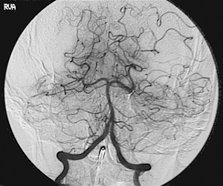Cerebral Angiogram Fact Sheet
What is a Cerebral Angiogram?
A cerebral angiogram (also known as a carotid angiogram) is an examination of the blood vessels in your neck and brain using x-rays and contrast (x-ray dye).
A specialist known as an Interventional Radiologist performs these procedures.
The contrast is injected through a thin plastic tube called a catheter, which is passed through a sheath inserted into the femoral artery.

Why do I need this procedure?
Your Doctor has asked for this cerebral angiogram procedure to be performed because you may have experienced some or all of the following symptoms;
- Ongoing headaches,
- Visual disturbances, slurred speech, memory loss.
- Dizziness or fainting not related to your heart.
- A family history of aneurysms or vascular abnormalities.
What should I expect?
- The procedure can take up to 60mins.
- The contrast can cause a warm flushing or burning sensation or metallic taste in your mouth. It only last for a few seconds and stops once the contrast has stopped being injected. Please ring MIVIR if you have a known allergy to Iodine or contrast.
- You may be required to take some time off work – please let the nurses know so they can organise a medical certificate for you. An attendance certificate can be provided for your carer on the day of the procedure.
- Please make sure you have someone to pick you up after your procedure. You procedure will be cancelled if you don’t have an escort. Please contact MIVIR as soon as possible if this cannot be arranged.
On the day of your Procedure
You will need to present to the Day Procedure Unit on the day of your procedure – your admission time will be sent to you with your appointment time. This will allow the nurses time to complete your admission paperwork and any other tests that may be required such as blood tests or pre-medication.
You will be required to fast for 4 hours before you procedure – this means no food or fluids. You may take any regular medication with a small sip of water. Please continue to take your blood pressure medication. Please bring a list of your medications with you.
Please contact MIVIR if you are taking medication for the following;
- Diabetes,
- Stroke,
- Heart Conditions such as a Heart Attack or Atrial Fibrillation.
Useful Links
Cerebral Angiography – Radiology Info
Cerebral Arteriogram – Johns Hopkins Medicine
Author: Dr John Vrazas
